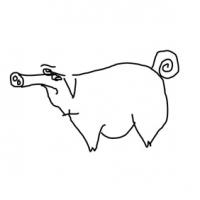- Even as we flip the corners of the square for infinite times, the only point that touch the circle are only the tangential points.
- Square is not a continuous function, thus we can't flip its corner to inifinity and believe that it becomes an arc
Pi = 4. Discuss.
Just a couple of thoughts:
Edge cases will show your design flaws in your code!
Visit my site
Visit my FaceBook
Visit my github
Visit my site
Visit my FaceBook
Visit my github
Quote: But why does this metric mean anything?
It means something because knowing that these extreme-hypotenuse-vertices always alternate with the valid vertices, this metric shows whether or not the shape smooths into a circle as n approaches infinity.
Since at the end we take the sum of the distances from each vertex to the next, I take the sum of the deviation.
It basically tells us if the points on the shape are becoming more equidistant from the center as n approaches infinity or not. Regardless of how it compares to any other procedure.
Quote: Another metric is how close the limiting figure is to a circle, which it passes.
Quote: You could also consider whether the enclosed area goes to zero, which it also passes.
There are many, many metrics (unlimited), and I did consider that one - the area.
Which would suggest that it is an approximation of a circle, and therefore useful to find Pi if you test the area.
And I stand by that; because its area should approach that of a circle as n approaches infinity, its area is an approximation for that of a circle, therefore anything we can infer from that can be accepted.
But...
Quote: As I said, in this case, the enclosed area is just the weighted deviation of all points normalized by the arc length.
It's always the case that you can predict the area from the geometry of an object; that the properties of its geometry will be reflected in its area.
But the reverse is not also true.
Area and perimeter both stem from the geometry, but the perimeter doesn't stem from the area. Since our goal is to use the perimeter at the end, we only need to examine what influences it.
Again, we cannot divorce how the figure is used from how we assess its fitness for purpose.
So for a metric to matter, it must make some prediction about the perimeter.
Quote: The same n isn't really comparable between the two, but the way they behave as n increases is comparable.
The comparison doesn't really matter. In fact, nevermind the regular polygon method. It doesn't matter how they compare; only whether or not the procedure in question does as it says on the tin.
In showing if this one does, it doesn't matter at all what the regular polygon method does at any value of n, nor does it matter whether or not the procedure exists at all!
So let's focus on this one.
In this method, we're trying to approximate a circle for the purpose of measuring its perimeter.
This method suggests that as n approaches infinity, the difference between it and a circle should approach 0, making it an approximation, and we can pick as high a value of n as we need accuracy.
Since the procedure uses the perimeter, to assess it, we need to ignore things that don't contribute to the perimeter and focus on whether or not the shape it uses approximates a circle's perimeter.
It starts with square edges, and appears to smooth out... But does it? We can assess whether or not it really does; we can measure whether it smooths out.
Since we know there are valid points, and between two valid points are extreme-hypotenuse-points, we can assess if these extremes go away as n approaches infinity.
Since the value goes up instead of down, we see that it does not, thus failing at its own goal, failing to approximate a circle' shape and therefore giving us no reason to accept its perimeter as an approximation of a circle's.
The fact that its area does is interesting, but that doesn't mean anything to its perimeter. Both the perimeter and area stem from the geometry. Therefore we should not consider its area.
Any better?
[Edited by - JoeCooper on December 4, 2010 5:59:21 AM]
Quote: Original post by Concentrate
Just a couple of thoughts:
- Even as we flip the corners of the square for infinite times, the only point that touch the circle are only the tangential points.
- Square is not a continuous function, thus we can't flip its corner to inifinity and believe that it becomes an arc
By your first argument, calculating the area of the circle using an n-gon is impossible too (either the edges just touch the circle or the vertices touch the circle). However, that is exactly how it is done.
I don't know why a square is not a continuous function though. You can have a go at it not being differentiable but I still do not see the point.
The thing is, as soon as you have things happening until infinity, a lot of things we believe to be common sense go out of the window. That's why it is so important to stay with the strict mathematical definitions of these processes, otherwise you always end up in hell's kitchen.
Just to make it clear again, I'm not arguing that the happy squares method is correct (it might be for area, but definitely not for circumference). But we are talking about math. The way is the goal. Having the correct solution with the wrong rationale is as bad as having the wrong solution.
I have written down one criteria for limits up there in the thread, I think Wikipedia has a slightly different definition posted (looked similar by using different means, but I haven't looked at it too closely). Go ahead, just don't use handwavium with limits. That never works out well.
I'm pretty sure it should be easy to explain with mathematics (convergence, "lim" stuff and formulas), but I want to be convinced with simple GEOMETRY. Just like Archimedes would. So that I can IMAGINE it.
I feel it has to so something with fractal geometry, but this thinking ("we can construct an object that looks like a line blah blah") seems to be too "reverse thinking" to me. I don't feel that warm "I'm convinced" feeling.
But maybe I'm trolling myself.
I feel it has to so something with fractal geometry, but this thinking ("we can construct an object that looks like a line blah blah") seems to be too "reverse thinking" to me. I don't feel that warm "I'm convinced" feeling.
But maybe I'm trolling myself.
Maybe we just need the definition of Pi.
I remain clueless.
I remain clueless.
[size="2"]I like the Walrus best.
Since this thread got started I spent quite a lot time reading on the subject, I even dared to post a completely uninformed opinion in this very same thread.
What I got so far is that the only way to get the famous Pi is to use inner polygons, the area of the circle or even the volume of a sphere. And that all this effort to approach Pi from a quad is useless.
I even remember my dad telling me (when I was just a kid) to take a string and measure a circle to see how much it's length was, and, if I'm not wrong, measuring with physical objects still gives a values closer to 3.14etc than 4.
What I got so far is that the only way to get the famous Pi is to use inner polygons, the area of the circle or even the volume of a sphere. And that all this effort to approach Pi from a quad is useless.
I even remember my dad telling me (when I was just a kid) to take a string and measure a circle to see how much it's length was, and, if I'm not wrong, measuring with physical objects still gives a values closer to 3.14etc than 4.
[size="2"]I like the Walrus best.
Way Walker, in case you already read my post, I rewrote it a tad.
(I rewrite and rewrite things a lot...)
(I rewrite and rewrite things a lot...)
Quote: Original post by szecs
I'm pretty sure it should be easy to explain with mathematics (convergence, "lim" stuff and formulas), but I want to be convinced with simple GEOMETRY. Just like Archimedes would. So that I can IMAGINE it.
I feel it has to so something with fractal geometry, but this thinking ("we can construct an object that looks like a line blah blah") seems to be too "reverse thinking" to me. I don't feel that warm "I'm convinced" feeling.
But maybe I'm trolling myself.
It seems to me the most evident geometric reason is that the tangents to the limit curve--the circle--exhibit all possible directions while the tangents to the zig-zag curves are always either horizontal or vertical. This is the basic geometric issue which prevents the limit machinery from working out as you would expect.
I pointed it out earlier in this thread, but since you mentioned Archimedes I'll say it again. The issue I just described does not occur when you use circumscribed n-gons like Archimedes did.
In the present example, we have uniform convergence of curves to a limit without convergence of the derivatives. In Archimedes' examples, we have both convergence of curves to a limit and convergence of the derivatives.
Quote: Original post by nilknQuote: Original post by szecs
I'm pretty sure it should be easy to explain with mathematics (convergence, "lim" stuff and formulas), but I want to be convinced with simple GEOMETRY. Just like Archimedes would. So that I can IMAGINE it.
I feel it has to so something with fractal geometry, but this thinking ("we can construct an object that looks like a line blah blah") seems to be too "reverse thinking" to me. I don't feel that warm "I'm convinced" feeling.
But maybe I'm trolling myself.
It seems to me the most evident geometric reason is that the tangents to the limit curve--the circle--exhibit all possible directions while the tangents to the zig-zag curves are always either horizontal or vertical. This is the basic geometric issue which prevents the limit machinery from working out as you would expect.
I pointed it out earlier in this thread, but since you mentioned Archimedes I'll say it again. The issue I just described does not occur when you use circumscribed n-gons like Archimedes did.
Well, to be honest, I don't see the connection. That's just a basic idea but no explanation. Okay, I should think about it.
Write down the integrals for the lengths in the two cases. On the one hand, you have the length of the limit curve. On the other hand, you have the limit of the lengths of the individual curve. There is in general no reason to suppose these two quantities should coincide. For instance, if you try to go from the second integral to the first, you will need to first pull the limit outside of the derivative operation which appears inside the integrand, but the derivatives, as far as I can tell, of the zig-zag curves don't even have a limit, let alone converge uniformly.
This topic is closed to new replies.
Advertisement
Popular Topics
Advertisement








